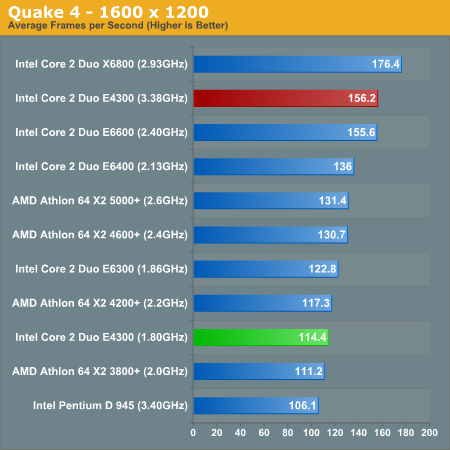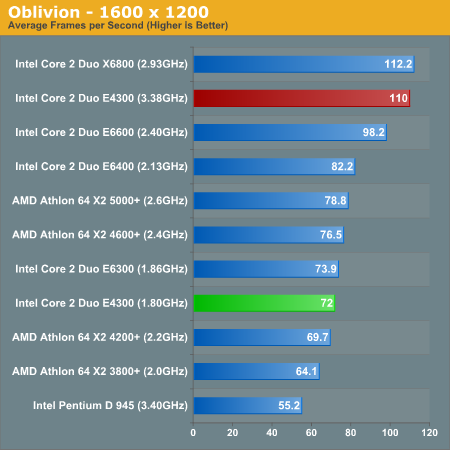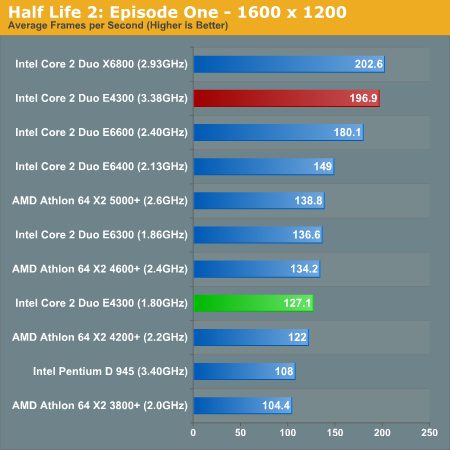Intel Core 2 Duo E4300: Affordable and Highly Overclockable
by Anand Lal Shimpi on January 10, 2007 2:45 AM EST- Posted in
- CPUs
Gaming Performance
Quake 4 performance is reasonably close to the E6300, but when overclocked it can't quite outpace the X6800. The X6800 manages to hold onto a 12% performance advantage even with the E4300 holding onto a clock speed advantage. At stock speeds the E4300 offers similar performance to the Athlon 64 X2 3800+.

Oblivion has always been friendlier to Intel's Core 2 architecture, and thus the E4300 has no problems outpacing the X2 3800+. Compared to the similarly priced Pentium D 945, the E4300 is significantly faster, as the Pentium D's NetBurst architecture has rarely been favored in games. Overclocked, the E4300 gets close to the X6800 but it is no faster.

Half-Life 2: Episode One echoes what we've seen from our other gaming tests - at stock speeds the E4300 is faster than the X2 3800+ and slightly slower than the E6300. When overclocked to 3.38GHz, the E4300 ends up getting close to the performance of the X6800 but it cannot surpass it due to the smaller L2 cache.











68 Comments
View All Comments
hubajube - Wednesday, January 10, 2007 - link
Nice OC and I might consider this instead of a E6400. I'll have to wait how the 4MB versions stack up. Also, I'd like to see how it OC's on a Nvidia chipset board. No DS3 for me.tuteja1986 - Wednesday, January 10, 2007 - link
SameIntelUser2000 - Wednesday, January 10, 2007 - link
The 4MB cache and faster FSB is good for performance, but also for raising stock performance from Intel's point of view. The extra cache and more bandwidth enables Core 2 Duo to scale better than the ones that don't. I would like to see E4300 at 800MHz FSB and clocked to say even E6600 speeds to see how it scales but I am expecting too much :P.E4300 at 3.38GHz has an FSB of 1500MHz, which is 40% more than the stock X6800.
IntelUser2000 - Wednesday, January 10, 2007 - link
From the idle power consumption measurements, it seems to use the new Core 2 Duo steppings that has C1E power consumption of 12W. You can see 8W difference from the normal Core 2 Duos, which are at 20W-22W(20W for E6700 and 22W for others).Goty - Wednesday, January 10, 2007 - link
Yeah, but that doesn't matter to 99% of the desktop consumer market. Most only care about power consumption at full load as it is usually a good indication of heat output.hubajube - Wednesday, January 10, 2007 - link
The only people that care about power consumption are geeks and corporate IT departments. Joe SixPack doesn't know and doesn't care. All they want is a machine that does email, stores porn, and surfs the web. You guys need to get out more often.Xentropy - Wednesday, January 10, 2007 - link
You can be sure even Joe SixPack will notice if turning on his PC sounds like a jet engine starting up, though, and higher power consumption means louder cooling solutions.hubajube - Thursday, January 11, 2007 - link
J6P still won't notice because they usually buy low rent Dell's and HP's not, custom built jobs like we have. Like I said, power consumption means nothing to regular computer buyers.